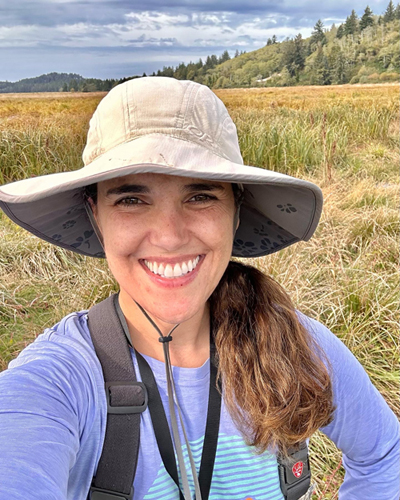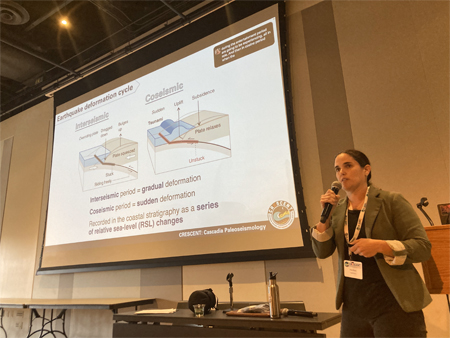16 April 2024–Tina Dura has always been interested in the natural world—from volcanoes to weather to “learning more about why the landscape looked the way it did,” she recalled. But the fieldwork she does as a paleoseismologist would not have appealed to her as a child. “It’s funny to me that I was afraid of camping, thinking that wild animals were going to attack the tent. And now I camp and do fieldwork in remote places all the time!”
 Dura, an assistant professor in the geosciences department at Virginia Tech, works in coastal paleoseismology, using everything from sedimentology to stratigraphy to paleoecology to find traces of sudden sea-level changes that correspond to earthquakes and tsunamis.
Dura, an assistant professor in the geosciences department at Virginia Tech, works in coastal paleoseismology, using everything from sedimentology to stratigraphy to paleoecology to find traces of sudden sea-level changes that correspond to earthquakes and tsunamis.
The 2004 Indian Ocean and tsunami “made a big impact on me as I thought about grad school. My undergraduate advisor knew of a colleague working in Sumatra looking at the 2004 tsunami and additional prehistoric tsunamis in the coastal stratigraphy,” she said. Dura joined the research team based out of Central Washington University and was able to conduct fieldwork in Sumatra, where the team scrutinized sediment cores for past signs of tsunamis and coseismic subsidence.
“Prior to 2004 we didn’t think that earthquakes of that size were possible in that region. All of the historical earthquakes leading up to that event had been in the low magnitude 8s,” Dura noted. “After the 2004 earthquake and tsunami, it became really important to understand the longer-term, thousands of years-long history of large ,over magnitude 9 earthquakes in the region and how they impacted the coasts.”
Dura’s research specialty is the application of microfossils in paleoseismic studies. Her microfossil of choice is diatoms, phytoplankton with glassy silica skeletons. Different species of diatoms live at different levels in the tidal frame, so their traces preserved in coastal sediment cores act as markers for specific elevations or environments of specific salinity.
She and her colleagues use these diatom markers along with radiocarbon dating to pinpoint where and when coastal sediments were uplifted or subsided during a seismic event, and to track sediments that were washed inland during a tsunami.
“Our [diatom] technique can provide the most information about where pre- and post-earthquake environments were located relative to the tidal frame,” she said. “We can use this information to quantify land-level change during large earthquakes going back thousands of years. This information can then be used to validate slip models and ultimately get a better sense of the size of past earthquakes.”
Microfossil-based paleoseismic studies add a new dimension to the quest to understand the coastal impacts of past large earthquakes and has changed how the field looks at famous subduction zones from Sumatra to Cascadia, Dura suggested.
“Before we started putting the stratigraphic, microfossil, and modeling evidence together, we didn’t have a good grasp of how many large, over magnitude 9 earthquakes had occurred along these subduction zones in the past, since there are few to no comparable events in our historical records,” she said.
“But now microfossil-based paleoseismology is a critical tool that we have to guide us in what to expect in the future,” Dura added, “showing us where we might expect inundation to reach, or where slip offshore was most concentrated and where we might expect strong shaking and significant land-level change along these margins in the future.”

Dura’s collaborative work has led to changes in seismic hazard maps in places like Alaska, for instance. The research there led to updated earthquake recurrence intervals calculated for places where her lab’s diatom studies offer new evidence that some regional earthquake segments have ruptured together in the past.
Her Coastal Hazards Laboratory at Virginia Tech is leading the Paleoseismology Working Group (CPAL) of the Cascadia Region Earthquake Science Center (CRESCENT), the United States’ first subduction zone earthquake hazards center, funded by a new $15 million National Science Foundation grant in 2023.
“The paleoseismic community worked hard to make sure microfossil-based paleoseismology was well represented in the proposal,” Dura said. “I am lucky to be leading that effort and I think the datasets we produce will be important to ground-truthing and validating modeling efforts.”
Dura’s program is one of the bigger labs around the world working on applying diatoms in paleoseismic studies. “There aren’t many groups doing diatom-based paleoseismology in academic settings,” she noted. “There is a big learning curve for the technique and it is very time consuming. But I just graduated my first Ph.D. student and my hope is that little by little the specialty will be better represented in universities across the U.S. and globally.”
To help train the next generation of paleoseismologists, CPAL is also running a Cores2Code Earthquake Geology summer camp that targets undergraduate students from underrepresented groups in geoscience, offering them training in fieldwork and geophysical modeling. “I’m really excited about the outreach component of CRESCENT,” Dura said. “It’s a great opportunity to diversify geosciences and continue to build the coastal geology and hazards workforce of the future.”
SSA At Work is a monthly column that follows the careers of SSA members. For the full list of issues, head to our At Work page.
